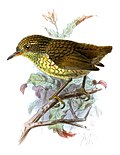| Meliphaga | |
|---|---|
 | |
| Lewin's honeyeater (Meliphaga lewinii) | |
| Scientific classification | |
| Kingdom: | Animalia |
| Phylum: | Chordata |
| Class: | Aves |
| Order: | Passeriformes |
| Family: | Meliphagidae |
| Genus: | Meliphaga Lewin, 1808 |
| Type species | |
| Meliphaga chrysotis[1] Lewin, 1808 | |
Meliphaga is a genus of birds in the honeyeater family Meliphagidae.
The genus was introduced by the English artist John Lewin in 1808.[2] The name Meliphaga combines the Ancient Greek meli meaning "honey" and phagos meaning eating.[3] The type species is Lewin's honeyeater (Meliphaga lewinii).[4][5]
In 2019 molecular phylogenetic studies found that Meliphaga was paraphyletic with the monotypic genus Oreornis, containing the orange-cheeked honeyeater, embedded within it. To created monophyletic genera, the genus was split up and species moved into the resurrected genera Territornis and Microptilotis, leaving just three species in Meliphaga.[6][7] In 2025 the AviList team instead adopted a broader Meliphaga that contained 17 species and included the orange-cheeked honeyeater.[8]
The genus contains 17 species:[8]
- Puff-backed honeyeater, Meliphaga aruensis – New Guinea including western Papuan islands, Aru and Trobriand islands, and D'Entrecasteaux Archipelago
- Yellow-spotted honeyeater, Meliphaga notata – northeast Australia
- Lewin's honeyeater, Meliphaga lewinii – east Australia
- Streak-breasted honeyeater, Meliphaga reticulata – eastern Lesser Sunda Islands (Timor and Semau)
- Kimberley honeyeater, Meliphaga fordiana – northwestern Australia (northwestern Kimberley region, northern Western Australia)
- White-lined honeyeater, Meliphaga albilineata – north-central Australia (Arnhem Land sandstone, northern Northern Territory)
- Orange-cheeked honeyeater, Meliphaga chrysogenys – west-central New Guinea (timberline zone of Snow Mountains)
- Forest honeyeater, Meliphaga montana – north to southeast New Guinea
- Mottle-breasted honeyeater, Meliphaga mimikae – montane west-central to southeastern New Guinea
- Yellow-gaped honeyeater, Meliphaga flavirictus – northeast Western Australia to northeast Queensland (north Australia)
- Mountain honeyeater, Meliphaga orientalis – montane New Guinea
- Scrub honeyeater, Meliphaga albonotata – foothills of southern New Guinea
- Mimic honeyeater, Meliphaga analoga – New Guinea including western Papuan islands and Aru Islands
- Tagula honeyeater, Meliphaga vicina – lowlands and hills of Tagula Island (Louisiade Archipelago, off southeastern New Guinea)
- Graceful honeyeater, Meliphaga gracilis – southern New Guinea including Aru Islands, and northeastern Australia (western Torres Strait islands and eastern Cape York Peninsula, northern Queensland)
- Cryptic honeyeater, Meliphaga imitatrix – northeastern Australia (southeastern Cape York Peninsula to Wet Tropics region, northern Queensland)
- Elegant honeyeater, Meliphaga cinereifrons – southeastern New Guinea
References
- ↑ "Melaphagidae". aviansystematics.org. The Trust for Avian Systematics. Retrieved 2023-07-16.
- ↑ Lewin, John William. Birds of New Holland, with their natural history. Vol. 1 (of one). London: Printed for the author and published by J. White and S. Bagster. p. 7.
- ↑ Jobling, James A. (2010). The Helm Dictionary of Scientific Bird Names. London: Christopher Helm. p. 249. ISBN 978-1-4081-2501-4.
- ↑ Paynter, Raymond A. Jr, ed. (1986). Check-list of Birds of the World. Vol. 12. Cambridge, Massachusetts: Museum of Comparative Zoology. p. 364.
- ↑ Gray, George Robert (1840). A List of the Genera of Birds : with an Indication of the Typical Species of Each Genus (1st ed.). London: R. and J.E. Taylor. p. 15.
- ↑ Andersen, M.J.; McCullough, J.M.; Friedman, N.R.; Peterson, A.T.; Moyle, R.G.; Joseph, L.; Nyári, A.S. (2019). "Ultraconserved elements resolve genus-level relationships in a major Australasian bird radiation (Aves: Meliphagidae)". Emu. 119 (3): 218–232. Bibcode:2019EmuAO.119..218A. doi:10.1080/01584197.2019.1595662. S2CID 150056949.
- ↑ McCullough, J.M.; Joseph, L.; Moyle, R.G.; Andersen, M.J. (2019). "Ultraconserved elements put the final nail in the coffin of traditional use of the genus Meliphaga (Aves: Meliphagidae)". Zoologica Scripta. 48 (4): 411–418. doi:10.1111/zsc.12350.
- 1 2 AviList Core Team (2025). "AviList: The Global Avian Checklist, v2025". doi:10.2173/avilist.v2025. Retrieved 11 November 2025.
